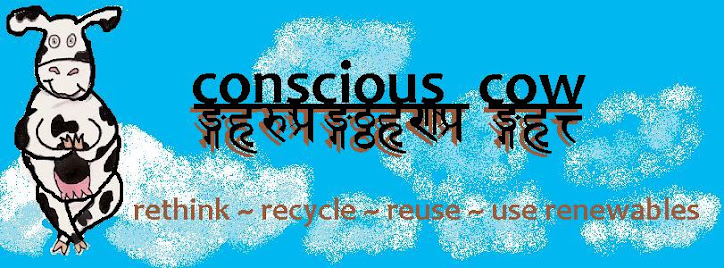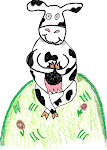Monday, January 3, 2011
Time to Say Goodbye
It's been a fun and fascinating journey for the Cow, and hopefully for you, too!
But since this blog launched, these topics have become more mainstream. You can now find all the info you need to reduce your hoof-print on the planet via TV, web, books, magazines... even iPhone apps! (the Cow just downloaded EcoSnoop).
Also, you may have noticed a dearth of blogposts at this site in recent months.
The Cow's alter-ego has been happily inundated with new commitments. She didn't want to neglect Conscious Cow; it just happened.
My friends, the time has come to say goodbye. Thank you for visiting and taking my message to heart.
one final time:
Ciao from the Cow!
Saturday, May 1, 2010
Recycled Washing Machine
Neither did Conscious Cow, until recently. The Cow is learning all about energy efficient appliances these days, so look for more news about RETHINKING energy consumption later.
For now, check out the energy star website for info on Recycling Your Washing Machine!
Ciao from the Cow!
Tuesday, March 9, 2010
Paper Industry Stops Trashing Planet
The good news is; the winds are changing, and while some old-school paper manufacturers wake up, new conscious paper manufacturers are entering the forest.
For example, Living tree paper offers tree-free (made with hemp & flax fibers) and recycled content paper products
An even eco-friendlier choice is Ecopaper made from agro-industrial waste (aka pre-consumer food waste), like coffee pulp and banana plant fibers that would normally be scrapped.
Greenfield Paper provides handmade plantable paper (paper with seeds in it, so you can skip the landfill and the recycling bin and let your words grow into flowers). This is the source for eco-cool note cards, stationary and even gift wrap.
There's more to this story, but for now...
Ciao from the Cow!
Tuesday, February 16, 2010
What are you printing on?
Conscious Cow loves books that wax poetic about recycling and reducing consumer waste. Conscious Cow also loves it when creatures walk their talk. Seriously, doesn’t it make sense for publishers of those “tree hugging” books to print them on 100% post-consumer recycled content?
Let’s save our magical leafed friends (aka trees) and use what’s already out there!
Steps YOU can take to reduce the number of trees felled each year:
- print on both sides of the paper
- reduce your font size (and use a magnifying glass if necessary)
- shrink the margins on the page
- buy tree-free paper (more about that in another post)
- cut used paper into squares for use as scrap paper
- save envelopes that come with bills & other correspondence for reuse as scrap paper
- shred used paper and make new paper
- call or email the publishers of your favorite books and tell them you want them to print books on 100% post-consumer recycled content paper
Saturday, January 30, 2010
Mostly Recycled Shoes from Kigo

(When folded, the shoe is about the same size as a wallet... super-convenient for urban commuters)
Rachelle Kuramoto, who co-founded the company, answered questions promptly and candidly.
Cow's first concern is: is the unique footwear made from 100% recycled materials?
Rachelle says, "The uppers and liners are recycled, the adhesives are water based, the insoles are EVA (which is not recycled but breaks down more rapidly than other soft–core rubber materials) and the stain treatment is non-toxic and EPA approved. The outsoles are currently the only non-eco friendly material, and we are meeting with the manufacturer this month to discuss a recycled or rice husk rubber option."
Cow's next question, which may be less important to other creatures and really has nothing to do with the 3 R's, is: are these shoes available in purple?
Rachelle says, not yet. "We actually prototyped a purple shoe, and it is still in the rotation, though not immediately. We appreciate the feedback – it helps us to decide how quickly to pull a color into the style lines!"
For taking initiative, making cool shoes (soon available in purple), and striving to improve the eco-footprint, by increasing the content of recycled materials in the product, Conscious Cow awards Kigo footwear 4 COW PIES. (when the outsoles are eco-friendlier, Kigo will get 5...) Bravo, .
Tuesday, January 26, 2010
Arugula Goes Green
Saturday, January 16, 2010
Conscious Coffee at Zumi's
 Owner Umesh Bhuju, a Nepal native, is sensitive to fair trade issues, and purchases all of his signature blends from a roaster who is also a pioneer in socially responsible coffee importing. Zumi's coffee is certified fair trade and organic, but Umesh doesn't stop there...
Owner Umesh Bhuju, a Nepal native, is sensitive to fair trade issues, and purchases all of his signature blends from a roaster who is also a pioneer in socially responsible coffee importing. Zumi's coffee is certified fair trade and organic, but Umesh doesn't stop there...  Check out the battery recycling station Umesh set up for members of the community to drop off their little bundles of chemicals-that-don't-belong-in-a-landfill! Zumi's has to pay to dispose of these batteries, so by collecting them, they're serving the community and mama earth!
Check out the battery recycling station Umesh set up for members of the community to drop off their little bundles of chemicals-that-don't-belong-in-a-landfill! Zumi's has to pay to dispose of these batteries, so by collecting them, they're serving the community and mama earth! Without question, Umesh Bhuju and Zumi's Coffee & Ice Cream have earned Conscious Cow's top honor of FIVE COW PIES!
Without question, Umesh Bhuju and Zumi's Coffee & Ice Cream have earned Conscious Cow's top honor of FIVE COW PIES!Friday, January 8, 2010
Papier Mache Goes Eco-Cool
In 1995, the artist began working with old newspapers to create elaborate papier mache pieces. Why newspaper? “It’s non toxic, inexpensive and a very hands on medium to work with,” she says.
How does she do it?
1) Tuesday starts by creating a relief design from clay

[the first step - a picture of a clay image]
2) Tuesday pours a plaster of Paris from the clay design
3) She shreds the newspaper, soaks it in water, and creates a mache by chopping the wet paper in a blender
4) After expelling the excess water, Tuesday adds water-based glue to the mache mixture
5) Finally, she places a design element (like a map or colored paper) in the plaster of Paris mold, and fills the rest of the mold with the paper mache
Sound easy?
Sometimes it takes 2-3 days to prepare colored paper combinations.
“I usually have several pieces going at one time. I may create anywhere from 2 - 6 frames in 2 - 3 days,” explains the artist.
Tuesday prepares the paper pulp in bulk by shredding the paper, soaking the paper in water for at least 2 days, and then chopping and expelling excess water, which takes about 3 hours.
She leaves the pulp exposed to air for about 5 -6 hours, which helps to dry out more of the water.
Once a piece is molded, it takes another 2 - 3 days to dry. Adding a mirror or picture frame backing takes an additional 1 day to dry.

["Tearsyellowpage" was designed with a telephone directory and yellow paper accents.]

[This black & white sunburst mirror is a 5" magnet picture frame designed with colored paper.]
Talk about dedication to craft! Tuesday has been doing this for fifteen years, and her work continues to evolve. Eventually she plans to make furniture & other useful items from papier mache. After that, she's thinking it'll be time to publish a book about functional papier mache designs.
About her materials:
Paper mache made from 100% post consumer waste
international stamps purchased by the pound from sellers via classified ads and the internet
imagery taken from discarded magazines
chlorine free, acid free, lignin free colored paper
maps from the Department of Defense. (printed in the USA.)
Tuesday’s favorite design element: the combinations of colored paper with recycled newsprint
Want one? Tuesday has done commission work for individuals and businesses and is available to do commissions. Check her out at www.mirrorsdecorated.com
For dedication, serious eco-cool, and vision, Conscious Cow awards Tuesday Winslow with FIVE COW PIES!
Until next time, Ciao from the Cow!
Thursday, April 9, 2009
Compost Consciousness

Read the label! Look for items made from: bagasse, bamboo, PLA, or potato starch.

Every year in the United States, we throw away 27 million tons of garbage. Much of that is food waste or recyclable material. Biodegradable items put in traditional landfills are usually mummified in the capping process used to protect groundwater.








